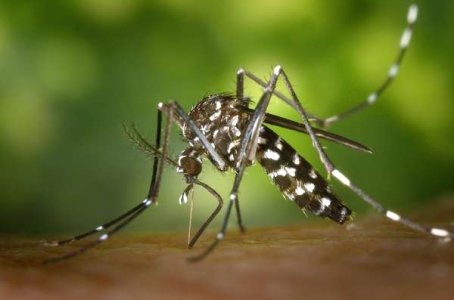Are you at risk? Record-breaking dengue fever surge predicted to worsen with climate change
- Replies 0
In the midst of a world still recovering from the aftermath of a global pandemic, a new health threat is making headlines and causing concern among experts and citizens alike. The culprit? A warming planet.
Dengue fever, a mosquito-borne viral infection, has surged to unprecedented levels in 2024, and scientists are warning that this could be just the beginning.
As we find ourselves in the middle of this terrifying surge, how can we protect ourselves and our communities?
Dengue fever isn't new, but the scale of the recent outbreak is.
In 2024, the Americas and Southeast Asia saw a staggering increase in dengue infections, with the Pan-American Health Organization reporting nearly 7,500 deaths and over 12.3 million cases—triple the number from the previous year.

The United States, particularly Puerto Rico, has been hit hard, with cases soaring from 1,462 in 2023 to nearly 7,300–leading to a declaration of a public health emergency in the country.
“Dengue is really having its biggest year in history,” according to Dr. Gabriela Paz-Bailey, chief of the U.S. Centers for Disease Control and Prevention’s dengue branch.
The symptoms of dengue can range from mild to severe, with the worst cases leading to internal bleeding, shock, and even death.
It's a disease that doesn't discriminate, but infants, the elderly, and pregnant women are especially vulnerable.
Researchers from prestigious institutions like the University of Maryland, Harvard, and Stanford have pinpointed climate change as a significant driver of the dengue spike.
Warmer global temperatures are expanding the habitat of the Aedes aegypti mosquito, the primary vector for dengue, into regions previously too cool for its survival.
The study presented at the American Society for Tropical Medicine and Hygiene meeting revealed that nearly a fifth of dengue cases are now attributable to climate change.
And the future looks even more concerning, with projections suggesting a 40% to 57% increase in cases by 2050 due to rising temperatures.
While climate change is a key factor, it's not the only one.
Urbanization, deforestation, and poverty create environments ripe for mosquito breeding. In the U.S., areas like Texas and Florida are particularly at risk.
Poor sanitation and lack of protective measures like air conditioning and window screens compound the problem, leaving the most vulnerable populations at even greater harm.
Paz-Bailey of the CDC says that the resurgence of travel post-COVID-19 has also played a role in the spread of dengue.
Infected travelers can bring the virus into new areas, where local mosquitoes can then transmit it to others. This pattern has already been observed in states like California and Florida.
While the situation may seem dire, there are glimmers of hope. Reducing greenhouse gas emissions can help mitigate climate change and, by extension, the spread of dengue.
Vaccines like Dengvaxia offer some protection, though access is limited and production is set to cease in 2025.
Innovative approaches, such as releasing mosquitoes infected with Wolbachia bacteria, have shown promise in reducing dengue transmission.
However, these solutions require time and sustained effort to be effective.
As we face this growing threat, there are steps we can take to protect ourselves.
According to Kristie Ebi, a professor at the University of Washington’s Center for Health and Global Environment, increased preparation is a must.
By covering our arms and legs with protective and loose-fitting clothing as well as spraying ourselves with insect repellant, we can avoid catching the illness.

Have you or someone you know been affected by dengue fever? What measures are you taking to protect yourself? Share your stories and tips in the comments below!
Dengue fever, a mosquito-borne viral infection, has surged to unprecedented levels in 2024, and scientists are warning that this could be just the beginning.
As we find ourselves in the middle of this terrifying surge, how can we protect ourselves and our communities?
Dengue fever isn't new, but the scale of the recent outbreak is.
In 2024, the Americas and Southeast Asia saw a staggering increase in dengue infections, with the Pan-American Health Organization reporting nearly 7,500 deaths and over 12.3 million cases—triple the number from the previous year.

Dengue fever infections have surged to record levels in 2024, with climate change being a significant factor in the increase. Image source: Pexels.
The United States, particularly Puerto Rico, has been hit hard, with cases soaring from 1,462 in 2023 to nearly 7,300–leading to a declaration of a public health emergency in the country.
“Dengue is really having its biggest year in history,” according to Dr. Gabriela Paz-Bailey, chief of the U.S. Centers for Disease Control and Prevention’s dengue branch.
The symptoms of dengue can range from mild to severe, with the worst cases leading to internal bleeding, shock, and even death.
It's a disease that doesn't discriminate, but infants, the elderly, and pregnant women are especially vulnerable.
Researchers from prestigious institutions like the University of Maryland, Harvard, and Stanford have pinpointed climate change as a significant driver of the dengue spike.
Warmer global temperatures are expanding the habitat of the Aedes aegypti mosquito, the primary vector for dengue, into regions previously too cool for its survival.
The study presented at the American Society for Tropical Medicine and Hygiene meeting revealed that nearly a fifth of dengue cases are now attributable to climate change.
And the future looks even more concerning, with projections suggesting a 40% to 57% increase in cases by 2050 due to rising temperatures.
While climate change is a key factor, it's not the only one.
Urbanization, deforestation, and poverty create environments ripe for mosquito breeding. In the U.S., areas like Texas and Florida are particularly at risk.
Poor sanitation and lack of protective measures like air conditioning and window screens compound the problem, leaving the most vulnerable populations at even greater harm.
Paz-Bailey of the CDC says that the resurgence of travel post-COVID-19 has also played a role in the spread of dengue.
Infected travelers can bring the virus into new areas, where local mosquitoes can then transmit it to others. This pattern has already been observed in states like California and Florida.
While the situation may seem dire, there are glimmers of hope. Reducing greenhouse gas emissions can help mitigate climate change and, by extension, the spread of dengue.
Vaccines like Dengvaxia offer some protection, though access is limited and production is set to cease in 2025.
Innovative approaches, such as releasing mosquitoes infected with Wolbachia bacteria, have shown promise in reducing dengue transmission.
However, these solutions require time and sustained effort to be effective.
As we face this growing threat, there are steps we can take to protect ourselves.
According to Kristie Ebi, a professor at the University of Washington’s Center for Health and Global Environment, increased preparation is a must.
By covering our arms and legs with protective and loose-fitting clothing as well as spraying ourselves with insect repellant, we can avoid catching the illness.
Key Takeaways
- Dengue fever infections have surged to record levels in 2024, with climate change being a significant factor in the increase.
- Nearly one-fifth of dengue infections in the Americas and Southeast Asia have been driven by climate change, and projections show further increases.
- Urbanisation, deforestation, and poverty are also contributing to the rise of dengue, alongside warming temperatures that expand the mosquitoes' habitat.
- While vaccines are currently limited in availability, research into mosquito modification shows promise in reducing dengue transmission.
Have you or someone you know been affected by dengue fever? What measures are you taking to protect yourself? Share your stories and tips in the comments below!






